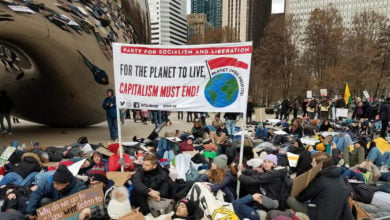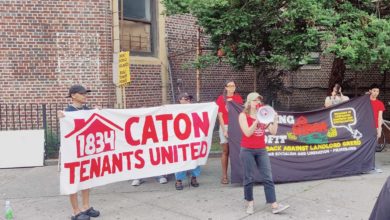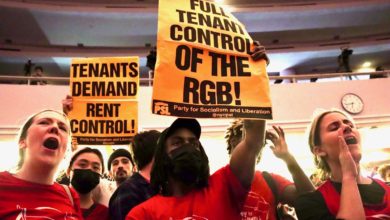Photo: Cori Bush speaks with other participants of the sit-in on the steps of Congress.
The authors were participants in the sit-in on the steps of Congress.
On July 30, Representative Cori Bush announced the start of a sit-in on the steps of the Capitol building in outraged response to the federal government’s failure to act to stop the wave of evictions that threatens millions across the country. Inspired by Rep. Bush’s action, hundreds of predominately young activists joined the sit-in, determined to spend all day and night at the Capitol until the nationwide eviction moratorium was reinstated.
This action led to a major victory. On August 3, the Biden administration by means of the Centers for Disease Control announced that the federal moratorium on evictions would be extended for 60 days in parts of the country with high rates of COVID-19 spread, an area that includes the vast majority of the U.S. population. The moratorium policy has kept around ten million people legally protected from eviction.
The action begins
On July 30, Rep. Bush began the sit-in on the steps of the Capitol building, with the clear demand that Congress renew the eviction moratorium before its August recess. Learning about the action mainly through social media, people traveled from within D.C. and from as far away as California to denounce Congress’ negligence. Many of those who left their beds for the cold sandstone steps of the Capitol building had never been engaged in a protest before, but inspired by the initiative of Rep. Bush, hundreds took up the task and held the steps.
By the end of the first day, it quickly became clear that Congress would not be returning from recess. The millionaires in Congress seemed to have chosen to ignore the sit-in, and it would take executive action by the Biden administration to prevent mass evictions. The focus then shifted to the White House, which had falsely been claiming their hands were tied and could not do anything to help. The participants in the sit-in stayed in place despite having had their sleeping bags confiscated on the first night and braced for the possibility of a lengthier struggle.
Congress feels the pressure
On days two and three, some other members of Congress began to arrive at the Capitol to speak with Rep. Bush and other attendees. Rev. Dr. William Barber and Rev. Dr. Liz Theoharis from the Poor People’s Campaign also joined the sit-in and spoke about the inaction of the Democratic Party and the necessity of cancelling the $60 billion in back rent that had accrued during the pandemic. Rev. Theoharis spoke in particular about the cruelly irrational current system where there are more empty homes in the United States than homeless people. Their message was one calling for fundamental change to the system. “If five to eleven million people get eviction notices, we’re talking about the crumbling of America,” warned Rev. Barber, “Woe unto those who legislate evil, rob the poor of their rights, and make women and children homeless.”
The fourth day saw the most attention of the week. Prominent leaders including Jesse Jackson were in attendance and brought a message of solidarity with the sit-in participants. Not only did progressive Democrats attend, but conservatives within the Democratic Party as well. This included Sen. Chuck Schumer and Rep. Adam Schiff, who flew back from California for fear of appearing insensitive to the people’s demands. Many other representatives had flown back from their constituencies during recess simply to be seen at the sit-in. It was clear that these politicians felt the pressure from not only Rep. Bush and the sit-in attendees but millions across the country who would be immediately impacted by the eviction catastrophe. It was understood among many of the sit-in participants that they had forced these politicians back to the Capitol.
On day five, the Biden administration announced a new eviction moratorium, causing a wave of celebration among the sit-in participants. The dozens of organizers spent a night of victory where they began, on the House steps, and began enthusiastically discussing what next actions could be taken to keep building pressure on the government to permanently resolve the housing crisis facing so many millions of working-class people. Since the beginning, there had been an understanding at the Capitol steps that Biden and Congress must not only issue a short-term extension of the the eviction moratorium, but also expand protections and take decisive action to clear the debt accumulated by so many renters over the course of the pandemic.
One urgent priority is the legal defense of the moratorium in its current limited form, as the multi-trillion dollar real estate industry is directing tremendous resources towards dismantling it and permitting the evictions of millions of households. The Supreme Court has historically served as a last line of defense for the most brutal policies of the ruling class, and signaled last month that it may strike down a new moratorium. But like any institution, the Supreme Court can be profoundly affected by the people’s movement.
The Party for Socialism and Liberation, whose members consistently participated in the sit-in, has been fighting since the beginning of the pandemic to demand the billions in accrued rent during the pandemic be immediately cancelled. The total rent owed is around $60 billion, which is equivalent to about 8% of the Pentagon’s war budget. While the politicians may claim this is impossible, the sit-in on the Capitol steps shows that the struggle can be decisive at key moments of crisis.





